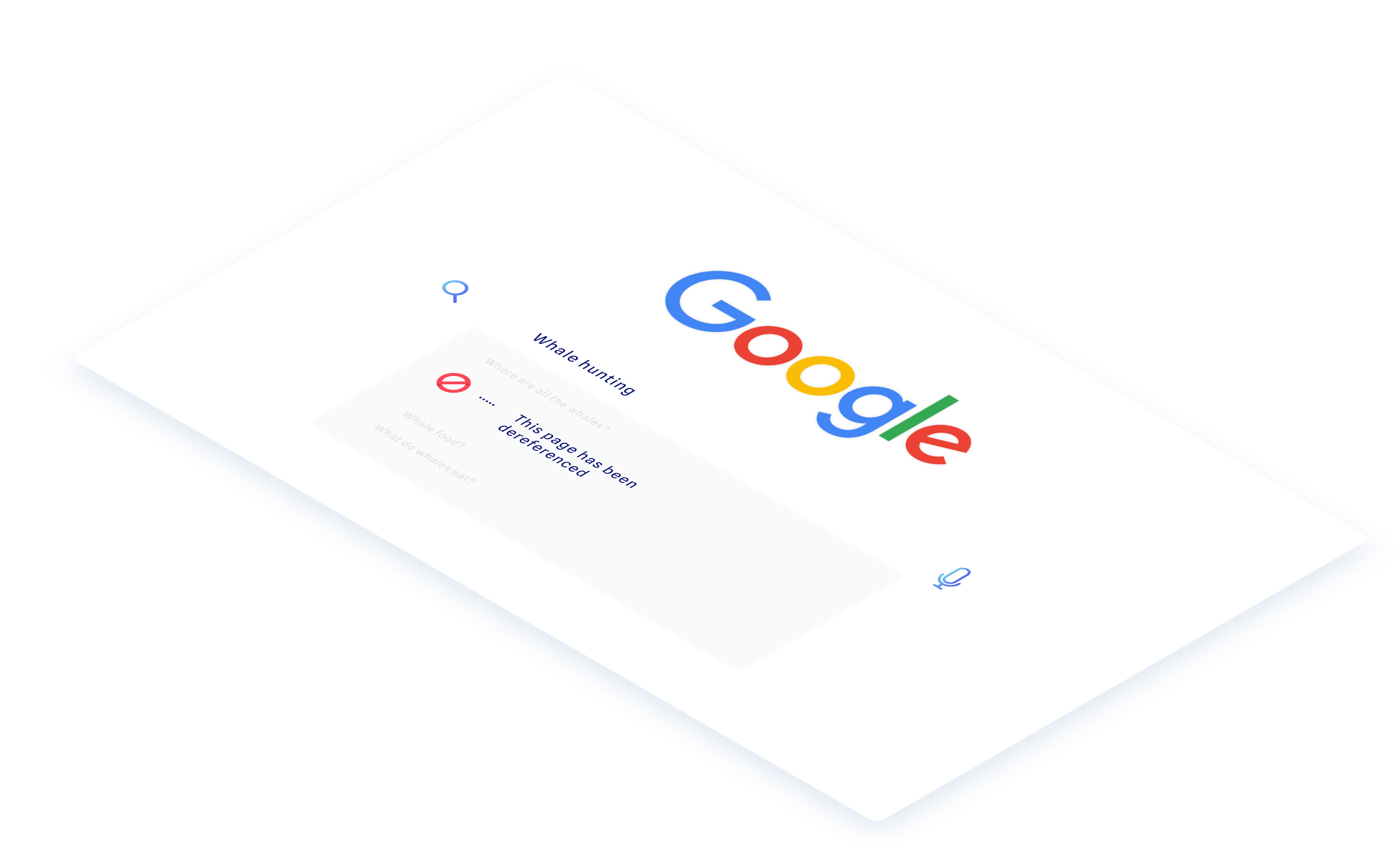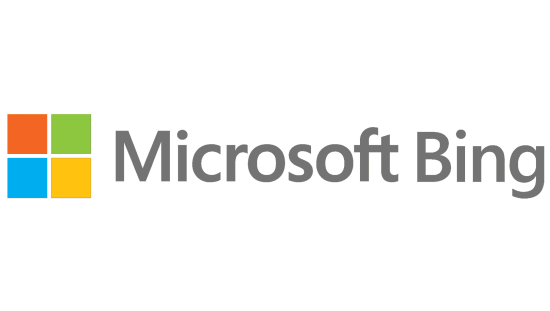
Dereferencing:
A Practical Guide
Dereferencing involves making a web page disappear from search engine results. Discover how to dereference a URL on a case-by-case basis.

What does URL dereferencing involve?
What does “dereferencing” mean?
The term “dereferencing,” in a broad sense, refers to an action aimed at removing a product, brand, or reference from a point of sale, initiated by the relevant organisation or an individual who requests it. In the context of the web, the term is used with a specific perspective: it involves making content vanish from the search engine results page (SERP). In this sense, dereferencing is the opposite of natural referencing: while SEO aims to position pages in the top results of the SERP, dereferencing seeks to do precisely the opposite. It can involve inappropriate, excessive, misleading, or outdated results that the individual or company no longer wishes to be publicly visible because they harm their online reputation.
Dereferencing and online reputation
The concept of dereferencing is closely related to that of “online reputation.” This expression refers to the image projected by an entity (individual, brand, company, institution) or a product/service, constructed from all the information available on the web: the traces left by users themselves as well as the content uploaded by third parties. When information is likely to harm the online reputation of a person or organisation, it’s necessary to attempt to remove it, and this is where dereferencing methods come into play. For businesses, brands, and public figures, this is particularly important as a negative buzz can have detrimental and lasting consequences. Moreover, the reputation of an entity is one of the referencing criteria considered by search engine robots.


What are the different ways to dereference a web page?
Dereferencing a web page can be achieved by various approaches. Here are some of them:
-
Request-based dereferencing (by an individual)
This method involves an individual requesting the removal or delisting of specific web content, under the right to be forgotten. The request is typically made directly to the website owner for content removal or to a search engine as the responsible party for data processing to request delisting.
-
SEO-based dereferencing (by a business)
In this approach, businesses employ search engine optimisation (SEO) techniques to push problematic pages beyond the visibility of internet users on the SERP. As the right to be forgotten does not apply to legal entities, this is the primary method for businesses to clean up their e-reputation and eliminate harmful content.
GOOD TO KNOW
Dereferencing does not result in the complete removal of a search result. It simply makes the content invisible to users on the SERP. The information still exists on the original source website, unchanged, and can be accessed through alternative means or search criteria. Additionally, dereferencing is governed by European legislation and is applicable only to EU member countries. Delisted results may still be accessible in other parts of the world.
Request-based dereferencing (for individuals)
Dereferencing and the right to erasure
Dereferencing is a right established by the European Union Court of Justice’s ruling on 13th May 2014, which acknowledges search engines as data controllers. This is commonly known as the “right to erasure”, or “right to be forgotten.” According to the law, any EU citizen has the right to request the removal of search engine results that are linked to their personal information. Essentially, this involves delisting content that appears in the SERP in response to a “name surname” query. The request can be made by directly contacting the offending website (referred to as content removal) or by asking search engines to handle it (referred to as dereferencing).

What criteria justify the dereferencing of a web page?
To be considered, a dereferencing request must meet several criteria. We have grouped them into four categories.
-
Criteria related to the complainant
Only individuals are protected by the right to be forgotten, excluding businesses, brands, institutions, and other organisations. The identity of the complainant is central to the dereferencing request, specifically concerning the results that appear in a “name surname” query. Public figures (politicians, artists, entrepreneurs, etc.) are also excluded, as the freedom of information takes precedence in such cases.
-
Criteria related to the information
The dereferencing request may target information that is inaccurate, misleading, or excessive. It may infringe upon the person’s privacy, be defamatory, or be slanderous. It could involve sensitive information regarding racial or ethnic origin, health, political opinions, personal wealth, religious beliefs, sexual orientation, etc. Additionally, the information may express an opinion rather than a verified fact.
-
Criteria related to harm
The information must also be considered as potentially causing harm to the complainant, meaning it has a disproportionately negative impact on their private life. For instance, it could refer to a minor past offence that holds no current relevance to the public (for criminal offences, the criteria vary depending on the severity of the offence). Alternatively, it could expose the person to risks such as identity theft or harassment.
-
Criteria related to the context
The context of the publication is also taken into account. This includes the individual’s age at the time the content was posted (with minors receiving greater protection), their lack of awareness regarding the nature of the information (such as a photo being published without their knowledge), as well as the nature of the hosting site (considering that media outlets may justify a duty to inform) and its compliance with regulations (application or non-application of the GDPR).
How to request the dereferencing of a web page
1
2
3
4
5
6
7
8
9
10
11
12
13
14
15
16
~
~
~
~
~
~
// Remove the rule as there is currently
if ($this->rule_exists ($resource_details[‘id’],
$role_details[‘id’])) {
if ($access == false) {
$details[‘access’] = $access;
$this->_sql->delete(‘acl_rules’), $details);
} else {
$this->_sql->update(‘acl_rules’,
array[‘access’ => $access];
}
foreach ($this->rules as $key => $rule) {
if (
}
}
Normal server.js
1/16 ln
-
Identify
Start by identifying the content holder associated with the dereferencing request: either the website owner or the search engine.
-
Contact
All search engines provide a request form for content removal, usually available online.
-
Fill in
Thoroughly complete the form fields: the relevant URL and the reason for the request, clearly explaining how the information is affecting your reputation.
-
Validate
Validate your request. In some cases, the organisation may require you to verify your identity by attaching a digital copy of a supporting document.
-
Keep a record
Remember to keep a record of your actions by taking a screenshot of your request to serve as evidence.
-
Be patient
Now, all you need to do is wait for a response from the organisation. Processing may take a few days, but the legal timeframe for a response ranges from one to three months.
What can you do if a search engine refuses your request?

Despite the right to be forgotten, the statistics are not in favour of the complainants: over 70% of dereferencing requests are rejected by search engines. The refusals are usually justified by emphasising the right to freedom of information, which grants websites the ability to publish information if it is deemed to be of public interest. The rules in this regard are somewhat unclear. However, one thing is certain: search engines are under no obligation to approve a request for delisting. If that is the case, there is only one option left: file a complaint with the local data protection authority and provide evidence of your previous attempts.

SEO-based dereferencing (for businesses)
Dereferencing: Different rules for businesses and brands
The right to be forgotten does not apply to non-public individuals. However, businesses, brands, and public figures also need to carefully manage their online reputation and address detrimental search results that can harm their image. Instead of attempting to remove harmful content (which is only possible in cases where the website’s actions are illegal, such as the unauthorised use of a registered trademark), an alternative approach is employed: leveraging SEO strategies to push down problematic information and promote positive content related to the entity. This method, known as “SEO-based dereferencing,” involves a proactive approach and requires developing a customised strategy in collaboration with an agency specialising in natural search engine optimisation.

Building reputation through flooding
SEO-based dereferencing involves actively working on enhancing the visibility and popularity of a business or brand to surpass problematic search results and replace them with positive and valuable content. This technique, often referred to as “flooding,” aims to effectively “bury” negative results by pushing them beyond the reach of most internet users who rarely venture beyond the first page of search engine results. While flooding can be effective, it is not a sustainable long-term solution as it requires generating a substantial volume of content within a short period, potentially compromising content quality. An alternative approach known as “SERP sculpting” focuses on creating optimised and high-value content with the goal of establishing a positive and enduring online reputation by leveraging SEO strategies.

Strategies for SEO-based dereferencing

-
Creating optimised content about the brand
When faced with a surge of harmful search results related to their brand, an entity should prioritise creating optimised content. This content should focus on the brand’s name and appear prominently in search results when users query it. It’s essential to cover the latest news about the company or its industry. Don’t forget to optimise the static pages of your website as well.
-
Producing high-value content
In the context of “SERP sculpting,” it’s crucial to concentrate on creating high-value content that is optimised for popular keywords. This approach is a fundamental aspect of SEO and involves managing a blog with a regular and consistent publishing schedule. These articles will ultimately help generate quality backlinks, contributing to successful linkbaiting.
-
Obtaining backlinks from authority websites
One effective method for improving the visibility of internal pages on your website is through netlinking. Backlinks carry significant SEO weight, so it’s important to target authoritative websites, ideally well-known media outlets or influential blogs. Google places great importance on the quality of referring domains that link to your pages.
-
Positioning in Google’s universal search
n the realm of SEO, Universal Search refers to the integration of additional media, such as images, videos, and maps, into the SERP. Google displays these content types in separate blocks, distinct from organic and paid links, often generating high click-through rates. To leverage this feature, publish relevant images and videos related to your brand.
-
Overwhelming the web with positive reviews
The technique of “flooding” can also be applied to customer review platforms (such as Google business listings, Trustpilot, etc.). Negative reviews can have a detrimental impact on your online reputation, and removing them can be challenging or even impossible, unless they contain defamatory, abusive, or false content. A good approach is to inundate them with a large number of positive reviews.
-
Being (very) active on social media
Although social media doesn’t directly influence SEO rankings, social activity is highly valued by Google and can prominently feature in the SERP. By regularly publishing high-quality posts, you can elevate the visibility of your social media pages associated with your entity in search results. This also adds a more human touch to your brand.
-
Employing some Negative SEO tactics
Some less conventional practices aim to tackle problematic results head-on. Borrowed from Negative SEO, these methods include duplicating a targeted article or generating toxic backlinks that point to the specific page, with the intention of attracting a penalty. However, it’s important to use these techniques only as a last resort and in conjunction with White Hat SEO strategies.
Our Commitment
-
Expertise
Since 2010, we have worked with over 2000 clients across 90 countries.
-
Passion
We are a team of passionate, industry-focused individuals who are committed to your success.
-
Performance
We’re committed to implementing a data-driven strategy, making a real impact on your bottom line by providing avenues for growth.
Any questions?
Dereferencing involves removing problematic content that appears on a search engine results page. The targeted content for dereferencing is that which harms the reputation of individuals or entities, potentially affecting their online reputation. This can include sensitive information disclosed without valid reason, inappropriate, defamatory, or abusive content, illicit use of personal data, or simply negative content.
An individual can request the dereferencing of a search result that harms them, based on the right to be forgotten. For search engines, the request is made through an online form and must be properly justified. However, companies, brands, public figures, and institutions do not benefit from the right to be forgotten. To protect their online reputation, they need to employ SEO-specific strategies.
To remove a search result that damages its online reputation, a company must use dereferencing through SEO. This method involves “flooding” the first page of the SERP with positive results, pushing the harmful content to subsequent pages that are less frequently viewed by users. It is also possible to “sculpt” the SERP by positioning a maximum number of optimised content pieces as part of a long-term SEO strategy.













